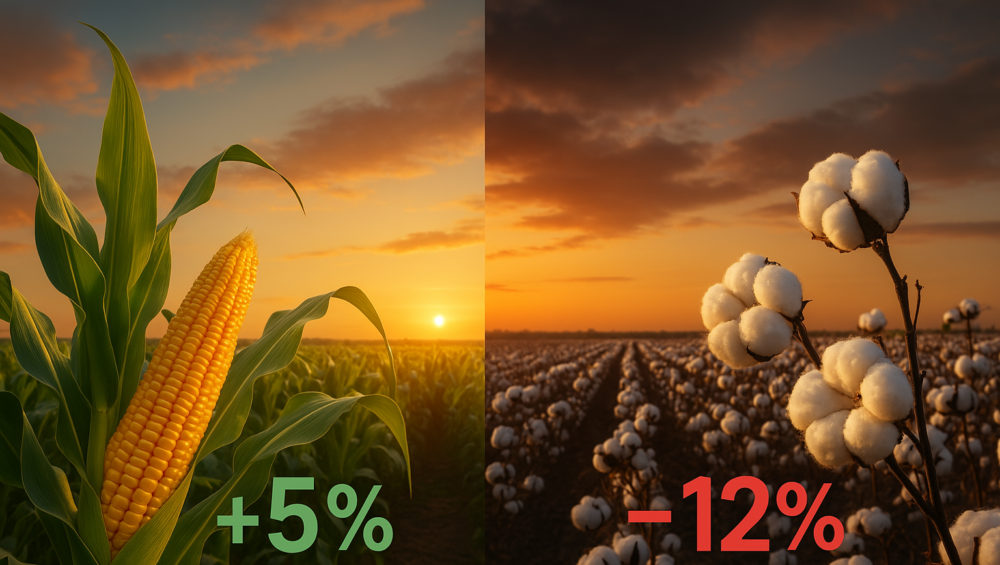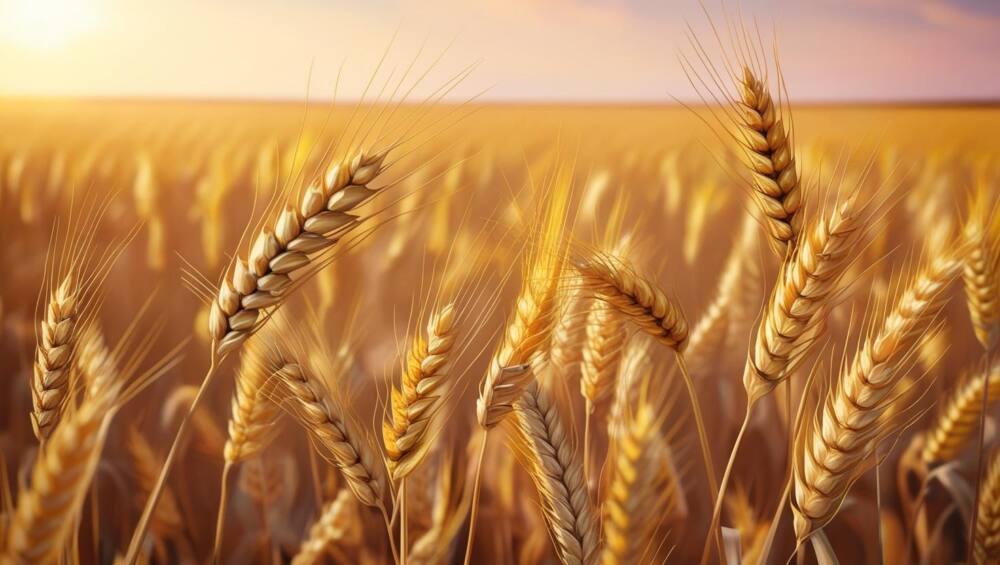2025 USDA Planting Report: Major Crop Shifts & Market Impact
Share This Story, Choose Your Platform!
2025 Farm Prospective Planting: Market-Moving Changes Ahead
Bottom Line Up Front
The March 31, 2025 USDA report reveals dramatic shifts in U.S. farming strategy. Corn acreage jumps 5% while cotton crashes 12% – changes that will ripple through commodity markets all year. These aren’t minor adjustments but significant bets by America’s farmers on where profits lie in 2025.
Corn: America’s Favorite Crop Gets Bigger
American farmers are betting big on corn this season. They plan to plant 95.3 million acres, up sharply from 90.6 million last year. This 5% jump isn’t happening in just a few places – 40 of 48 states report growing more corn or holding steady.
The major corn belt states are leading this charge. Iowa, Minnesota, Nebraska, and South Dakota are each adding more than 400,000 acres. Even more telling are the new records expected in Idaho, Nevada, North Dakota, Oregon, and South Dakota. Farmers are voting with their fields, seeing strong profit potential in corn markets for the coming year.
This corn expansion signals confidence in ethanol demand, livestock feed requirements, and export opportunities. With more acres coming online, buyers might find price relief if weather cooperates during the growing season.
Soybeans: Losing Ground to Corn
Soybean fields are shrinking across America. Farmers plan to plant 83.5 million acres, down from 87.6 million last year. This 4% retreat shows many growers favoring corn in their crop rotation decisions.
The pullback is widespread, with 23 of 29 soybean states cutting back or staying flat. Several major producing states are slashing more than 300,000 acres each. Only New York and Ohio swim against this tide, with both states expecting record soybean plantings.
This soybean reduction suggests farmers see better returns in corn this year. Export uncertainties may also be weighing on planting decisions. With fewer acres, soybean prices could find support unless yields surprise to the upside.
Wheat: Historic Decline Continues
Wheat’s long-term decline in American agriculture continues. Farmers intend to plant 45.4 million wheat acres, down from 46.4 million last year. This 2% drop would result in the second lowest wheat acreage since record-keeping began in 1919.
Not all wheat varieties face the same fate. Winter wheat is holding relatively steady with less than a 1% decline. Spring wheat bears the brunt with a steeper 6% reduction, while durum wheat splits the difference with a 2% drop. California and Virginia expect to set all-time lows for winter wheat acreage.
These numbers confirm wheat’s struggles against more profitable row crops. U.S. wheat prices will increasingly depend on global production and export competition, as domestic acreage shrinks to historic lows.
Hay: Regional Production Shifts
Hay fields face modest reductions nationwide. Farmers plan to harvest 48.5 million acres, down from 49.5 million last year. This 2% decrease masks significant regional variations.
The geographic extremes tell the real story. Record low hay acreage is expected in Massachusetts, Michigan, North Dakota, and Washington. Meanwhile, Florida stands alone with anticipated record high production. These regional shifts reflect changing weather patterns and livestock population movements.
Hay markets remain stubbornly local, with transportation costs limiting long-distance movement. The regional production changes will create scattered pockets of tight supply and surplus throughout the country.
Cotton: Dramatic Abandonment
Cotton faces the most dramatic retreat of any major crop. Acreage is plunging to 9.87 million from 11.2 million last year – a steep 12% decline that signals serious concerns about cotton economics. Read our previous article.
The abandonment is nearly universal. Only Arizona and Kansas plan to increase cotton acres, while every other cotton-producing state cuts back. Louisiana and New Mexico will hit record lows if current plans hold. Cotton growers clearly see the writing on the wall and are moving to more profitable alternatives.
This cotton collapse suggests weak textile demand, strong international competition, or more attractive options for limited farmland. With significantly fewer acres, cotton prices could find support if global demand holds steady.
Sorghum: The Quiet Climber
Sorghum emerges as a surprise winner in the 2025 planting decisions. Farmers plan to grow 6.57 million acres, up from 6.30 million last year. This 4% increase flies under the radar of many market watchers but represents a meaningful shift.
Kansas, America’s sorghum capital, plans a 3% expansion. More impressive is Texas with its 12% planned increase. This drought-tolerant crop continues gaining fans as climate concerns mount and water restrictions spread across farming regions.
Sorghum’s versatility adds to its appeal. The crop serves multiple markets from livestock feed to ethanol production to gluten-free food products. This acreage growth could pressure prices unless new demand sources emerge.
Market Implications Worth Watching
These planting intentions aren’t academic – they reveal where American farmers are placing billion-dollar bets for 2025. The corn surge shows genuine optimism about domestic and export demand. Wheat’s stubborn decline highlights its diminishing role in U.S. agriculture.
Cotton’s collapse stands out as the most dramatic market signal. Growers anticipate serious challenges ahead from weak global demand or excessive competition. Smart commodity traders will watch early-season cotton prices closely for confirmation of this bearish outlook.
Sorghum’s steady climb speaks to changing farm economics and adaptation to uncertain weather patterns. More farmers want its water-efficient properties and market flexibility as growing conditions become less predictable.
Remember that these numbers represent intentions, not final plantings. Weather delays, price swings, and last-minute decisions will alter the final acreage mix. But the direction is clear: corn and sorghum gaining, soybeans and cotton losing, with wheat continuing its historic decline.
Quick Reference: 2025 Planting Numbers
| Crop | 2025 Planned Acres | 2024 Actual Acres | Percent Change |
|---|---|---|---|
| Corn | 95.3 million | 90.6 million | +5% |
| Soybeans | 83.5 million | 87.6 million | -4% |
| Wheat | 45.4 million | 46.4 million | -2% |
| Hay | 48.5 million | 49.5 million | -2% |
| Cotton | 9.87 million | 11.2 million | -12% |
| Sorghum | 6.57 million | 6.30 million | +4% |
Share This Story, Choose Your Platform!
2025 USDA Planting Report: Major Crop Shifts & Market Impact
Share This Story, Choose Your Platform
2025 Farm Prospective Planting: Market-Moving Changes Ahead
Bottom Line Up Front
The March 31, 2025 USDA report reveals dramatic shifts in U.S. farming strategy. Corn acreage jumps 5% while cotton crashes 12% – changes that will ripple through commodity markets all year. These aren’t minor adjustments but significant bets by America’s farmers on where profits lie in 2025.
Corn: America’s Favorite Crop Gets Bigger
American farmers are betting big on corn this season. They plan to plant 95.3 million acres, up sharply from 90.6 million last year. This 5% jump isn’t happening in just a few places – 40 of 48 states report growing more corn or holding steady.
The major corn belt states are leading this charge. Iowa, Minnesota, Nebraska, and South Dakota are each adding more than 400,000 acres. Even more telling are the new records expected in Idaho, Nevada, North Dakota, Oregon, and South Dakota. Farmers are voting with their fields, seeing strong profit potential in corn markets for the coming year.
This corn expansion signals confidence in ethanol demand, livestock feed requirements, and export opportunities. With more acres coming online, buyers might find price relief if weather cooperates during the growing season.
Soybeans: Losing Ground to Corn
Soybean fields are shrinking across America. Farmers plan to plant 83.5 million acres, down from 87.6 million last year. This 4% retreat shows many growers favoring corn in their crop rotation decisions.
The pullback is widespread, with 23 of 29 soybean states cutting back or staying flat. Several major producing states are slashing more than 300,000 acres each. Only New York and Ohio swim against this tide, with both states expecting record soybean plantings.
This soybean reduction suggests farmers see better returns in corn this year. Export uncertainties may also be weighing on planting decisions. With fewer acres, soybean prices could find support unless yields surprise to the upside.
Wheat: Historic Decline Continues
Wheat’s long-term decline in American agriculture continues. Farmers intend to plant 45.4 million wheat acres, down from 46.4 million last year. This 2% drop would result in the second lowest wheat acreage since record-keeping began in 1919.
Not all wheat varieties face the same fate. Winter wheat is holding relatively steady with less than a 1% decline. Spring wheat bears the brunt with a steeper 6% reduction, while durum wheat splits the difference with a 2% drop. California and Virginia expect to set all-time lows for winter wheat acreage.
These numbers confirm wheat’s struggles against more profitable row crops. U.S. wheat prices will increasingly depend on global production and export competition, as domestic acreage shrinks to historic lows.
Hay: Regional Production Shifts
Hay fields face modest reductions nationwide. Farmers plan to harvest 48.5 million acres, down from 49.5 million last year. This 2% decrease masks significant regional variations.
The geographic extremes tell the real story. Record low hay acreage is expected in Massachusetts, Michigan, North Dakota, and Washington. Meanwhile, Florida stands alone with anticipated record high production. These regional shifts reflect changing weather patterns and livestock population movements.
Hay markets remain stubbornly local, with transportation costs limiting long-distance movement. The regional production changes will create scattered pockets of tight supply and surplus throughout the country.
Cotton: Dramatic Abandonment
Cotton faces the most dramatic retreat of any major crop. Acreage is plunging to 9.87 million from 11.2 million last year – a steep 12% decline that signals serious concerns about cotton economics. Read our previous article.
The abandonment is nearly universal. Only Arizona and Kansas plan to increase cotton acres, while every other cotton-producing state cuts back. Louisiana and New Mexico will hit record lows if current plans hold. Cotton growers clearly see the writing on the wall and are moving to more profitable alternatives.
This cotton collapse suggests weak textile demand, strong international competition, or more attractive options for limited farmland. With significantly fewer acres, cotton prices could find support if global demand holds steady.
Sorghum: The Quiet Climber
Sorghum emerges as a surprise winner in the 2025 planting decisions. Farmers plan to grow 6.57 million acres, up from 6.30 million last year. This 4% increase flies under the radar of many market watchers but represents a meaningful shift.
Kansas, America’s sorghum capital, plans a 3% expansion. More impressive is Texas with its 12% planned increase. This drought-tolerant crop continues gaining fans as climate concerns mount and water restrictions spread across farming regions.
Sorghum’s versatility adds to its appeal. The crop serves multiple markets from livestock feed to ethanol production to gluten-free food products. This acreage growth could pressure prices unless new demand sources emerge.
Market Implications Worth Watching
These planting intentions aren’t academic – they reveal where American farmers are placing billion-dollar bets for 2025. The corn surge shows genuine optimism about domestic and export demand. Wheat’s stubborn decline highlights its diminishing role in U.S. agriculture.
Cotton’s collapse stands out as the most dramatic market signal. Growers anticipate serious challenges ahead from weak global demand or excessive competition. Smart commodity traders will watch early-season cotton prices closely for confirmation of this bearish outlook.
Sorghum’s steady climb speaks to changing farm economics and adaptation to uncertain weather patterns. More farmers want its water-efficient properties and market flexibility as growing conditions become less predictable.
Remember that these numbers represent intentions, not final plantings. Weather delays, price swings, and last-minute decisions will alter the final acreage mix. But the direction is clear: corn and sorghum gaining, soybeans and cotton losing, with wheat continuing its historic decline.
Quick Reference: 2025 Planting Numbers
| Crop | 2025 Planned Acres | 2024 Actual Acres | Percent Change |
|---|---|---|---|
| Corn | 95.3 million | 90.6 million | +5% |
| Soybeans | 83.5 million | 87.6 million | -4% |
| Wheat | 45.4 million | 46.4 million | -2% |
| Hay | 48.5 million | 49.5 million | -2% |
| Cotton | 9.87 million | 11.2 million | -12% |
| Sorghum | 6.57 million | 6.30 million | +4% |
Share This Story, Choose Your Platform!
2025 USDA Planting Report: Major Crop Shifts & Market Impact
Share This Story, Choose Your Platform
2025 Farm Prospective Planting: Market-Moving Changes Ahead
Bottom Line Up Front
The March 31, 2025 USDA report reveals dramatic shifts in U.S. farming strategy. Corn acreage jumps 5% while cotton crashes 12% – changes that will ripple through commodity markets all year. These aren’t minor adjustments but significant bets by America’s farmers on where profits lie in 2025.
Corn: America’s Favorite Crop Gets Bigger
American farmers are betting big on corn this season. They plan to plant 95.3 million acres, up sharply from 90.6 million last year. This 5% jump isn’t happening in just a few places – 40 of 48 states report growing more corn or holding steady.
The major corn belt states are leading this charge. Iowa, Minnesota, Nebraska, and South Dakota are each adding more than 400,000 acres. Even more telling are the new records expected in Idaho, Nevada, North Dakota, Oregon, and South Dakota. Farmers are voting with their fields, seeing strong profit potential in corn markets for the coming year.
This corn expansion signals confidence in ethanol demand, livestock feed requirements, and export opportunities. With more acres coming online, buyers might find price relief if weather cooperates during the growing season.
Soybeans: Losing Ground to Corn
Soybean fields are shrinking across America. Farmers plan to plant 83.5 million acres, down from 87.6 million last year. This 4% retreat shows many growers favoring corn in their crop rotation decisions.
The pullback is widespread, with 23 of 29 soybean states cutting back or staying flat. Several major producing states are slashing more than 300,000 acres each. Only New York and Ohio swim against this tide, with both states expecting record soybean plantings.
This soybean reduction suggests farmers see better returns in corn this year. Export uncertainties may also be weighing on planting decisions. With fewer acres, soybean prices could find support unless yields surprise to the upside.
Wheat: Historic Decline Continues
Wheat’s long-term decline in American agriculture continues. Farmers intend to plant 45.4 million wheat acres, down from 46.4 million last year. This 2% drop would result in the second lowest wheat acreage since record-keeping began in 1919.
Not all wheat varieties face the same fate. Winter wheat is holding relatively steady with less than a 1% decline. Spring wheat bears the brunt with a steeper 6% reduction, while durum wheat splits the difference with a 2% drop. California and Virginia expect to set all-time lows for winter wheat acreage.
These numbers confirm wheat’s struggles against more profitable row crops. U.S. wheat prices will increasingly depend on global production and export competition, as domestic acreage shrinks to historic lows.
Hay: Regional Production Shifts
Hay fields face modest reductions nationwide. Farmers plan to harvest 48.5 million acres, down from 49.5 million last year. This 2% decrease masks significant regional variations.
The geographic extremes tell the real story. Record low hay acreage is expected in Massachusetts, Michigan, North Dakota, and Washington. Meanwhile, Florida stands alone with anticipated record high production. These regional shifts reflect changing weather patterns and livestock population movements.
Hay markets remain stubbornly local, with transportation costs limiting long-distance movement. The regional production changes will create scattered pockets of tight supply and surplus throughout the country.
Cotton: Dramatic Abandonment
Cotton faces the most dramatic retreat of any major crop. Acreage is plunging to 9.87 million from 11.2 million last year – a steep 12% decline that signals serious concerns about cotton economics. Read our previous article.
The abandonment is nearly universal. Only Arizona and Kansas plan to increase cotton acres, while every other cotton-producing state cuts back. Louisiana and New Mexico will hit record lows if current plans hold. Cotton growers clearly see the writing on the wall and are moving to more profitable alternatives.
This cotton collapse suggests weak textile demand, strong international competition, or more attractive options for limited farmland. With significantly fewer acres, cotton prices could find support if global demand holds steady.
Sorghum: The Quiet Climber
Sorghum emerges as a surprise winner in the 2025 planting decisions. Farmers plan to grow 6.57 million acres, up from 6.30 million last year. This 4% increase flies under the radar of many market watchers but represents a meaningful shift.
Kansas, America’s sorghum capital, plans a 3% expansion. More impressive is Texas with its 12% planned increase. This drought-tolerant crop continues gaining fans as climate concerns mount and water restrictions spread across farming regions.
Sorghum’s versatility adds to its appeal. The crop serves multiple markets from livestock feed to ethanol production to gluten-free food products. This acreage growth could pressure prices unless new demand sources emerge.
Market Implications Worth Watching
These planting intentions aren’t academic – they reveal where American farmers are placing billion-dollar bets for 2025. The corn surge shows genuine optimism about domestic and export demand. Wheat’s stubborn decline highlights its diminishing role in U.S. agriculture.
Cotton’s collapse stands out as the most dramatic market signal. Growers anticipate serious challenges ahead from weak global demand or excessive competition. Smart commodity traders will watch early-season cotton prices closely for confirmation of this bearish outlook.
Sorghum’s steady climb speaks to changing farm economics and adaptation to uncertain weather patterns. More farmers want its water-efficient properties and market flexibility as growing conditions become less predictable.
Remember that these numbers represent intentions, not final plantings. Weather delays, price swings, and last-minute decisions will alter the final acreage mix. But the direction is clear: corn and sorghum gaining, soybeans and cotton losing, with wheat continuing its historic decline.
Quick Reference: 2025 Planting Numbers
| Crop | 2025 Planned Acres | 2024 Actual Acres | Percent Change |
|---|---|---|---|
| Corn | 95.3 million | 90.6 million | +5% |
| Soybeans | 83.5 million | 87.6 million | -4% |
| Wheat | 45.4 million | 46.4 million | -2% |
| Hay | 48.5 million | 49.5 million | -2% |
| Cotton | 9.87 million | 11.2 million | -12% |
| Sorghum | 6.57 million | 6.30 million | +4% |






